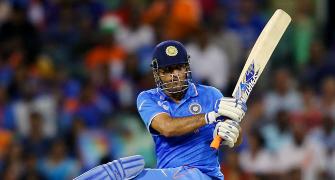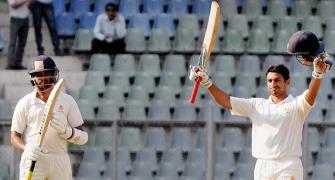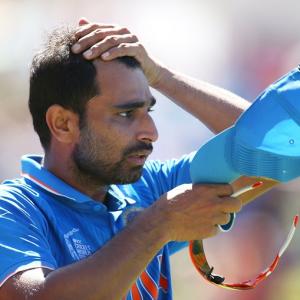'The two batted as if "pressure" was a concept unknown to them. Raina was the muscular enforcer, Dhoni the consigliere planning and controlling the momentum of the assault.'
Prem Panicker, in splendid form, on India's toughest game yet.

Brendan Taylor came half-forward to the third ball of the 39th over, realised that Mohammed Shami had banged it in short, provised brilliantly and ramped it over the keeper with the casual panache of a masterchef flipping an omelette.
The stroke, which ended up in the stands behind M S Dhoni's back, brought up Taylor's second century (99 balls) on the trot to go with his 121 against Ireland at Hobart on March 7.
At that point, his wagonwheel looked like a burst bag of vermicelli -- sticks long and short pointing to every corner of the compass, testament to a stylist who seemed to have at least two answers to every question a bowler posed.
The Zimbabwe captain celebrated with the emotional fervour of a player who knows he will never hold center-stage again. As the World Cup heads into the business end Taylor -- who with 433 is the second highest run-getter at this point of the World Cup behind that other retiree, Kumar Sangakkara -- will head off to do mercenary duty for Nottinghamshire as a Kolpak signee.
'Please,' Zimbabwe's coach pro tempore Dav Whatmore pleaded on the eve of this game, 'we would like to play more cricket.' Taylor's abdication underscores that cri de coeur -- talent decays with disuse, it demands a stage, a spotlight for its deeds; it is a failure of the international establishment that such as him are forced to turn journeymen.
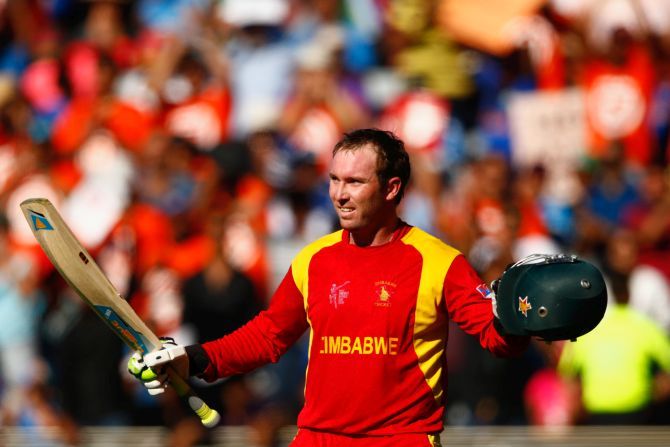
If the denouement of Taylor's innings was electric, its beginning was slow. India's opening bowlers Umesh Yadav and Mohammed Shami had taken out the openers and reduced Zimbabwe to 13/2 at the end of five overs and were threatening a rout.
The Zimbabwean captain gave himself a nine-ball sighter, eased a single to get off the mark, and absorbed the loss of Solomon Mire in the 11th over 33 for 3).
Joined in the middle by Sean Williams, the inheritor of his mantle, Taylor settled into an association that first rescued, then revived and finally, demolished.
For all their relative inexperience on the international stage, the two showed remarkable maturity in the way they rebuilt the tattered innings. Playing spin with skill and pace with intent, scoring largely through intelligent placements and brisk running, flexing their hitting muscles only when presented with the occasional bad ball, the two eased the score to 100 (149 deliveries, 24.5 overs) at almost exactly the half-way point of the innings.
Almost as if he were waiting for that first sighting of a safe harbor, Williams promptly shifted gears. He greeted Ashwin, going around the wicket, with a shimmy down the pitch off the first ball of the 26th over and smashed one over midwicket; one ball later he was down the wicket again, reading Ashwin's alteration of line to middle and leg and lofting over backward square leg; again he let a ball go and then came skipping down to convert a length ball into a full toss and smash through extra-cover to rattle up 16 in the over.
First Taylor, then Williams, brought up their fifties in the 28th over; Ashwin switched ends for the 29th and, with commendable flexibility, got down low to take a return chance off Williams (50 off 57, 3 fours and 3 sixes) as the batsman attempted to smash him straight (126/4).
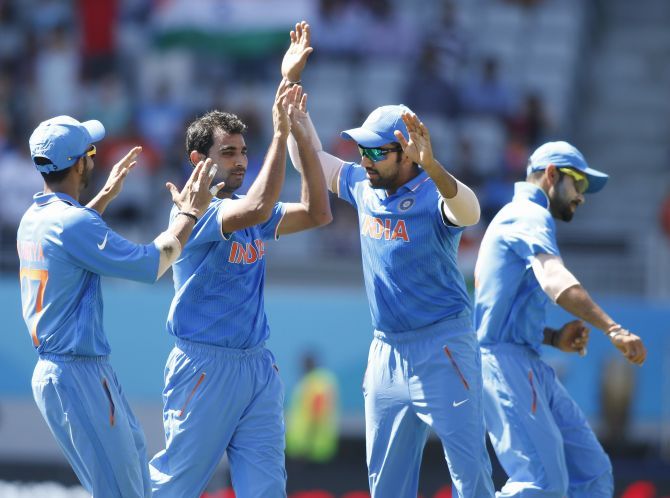
Taylor, now joined by Craig Ervine, eased through a few overs to absorb the loss of his accomplice and then eased through the gears. He swept Ashwin to the square leg fence and when the under-pressure bowler altered his length, went low to power him high over the backward square leg fence.
Dhoni gave his off-spinner a one-over break to recover his composure and brought him back in the 38th; Taylor took to him again, first sweeping a brace, then lofting him back over his head to the straight boundary and ending the over with a controlled clip off his pads through backward square leg.
In the next over the Zimbabwean captain ramped Shami for the six that got him to his century, and celebrated by lofting the last ball of the same over high over the mid-off fence.
Throughout his knock, Taylor had been perfecting the timing on his wide repertoire of stroke in which the sweep stood out. He played the conventional variety, the slog-sweep and the reverse with assured vehemence, and a frequency that made him the perfect candidate for a Swach Bharat campaign.
Having made sure that his arsenal was in working order, Taylor unleashed hell -- and Ravi Jadeja, in the 41st over, was the one who found himself under the bludgeon. The second hall, tossed outside off, was slog-swept with a feral ferocity through suare leg. Taylor waltzed down to the next ball and when Jadeja angled it into the pads, smashed that behind square.
Jadeja responded with a quicker delivery; Taylor responded with a stunning drive deep into the stands at long on. Jadeja shortened the length on the next ball, Taylor paddled to fine leg for another four.
And when the hapless bowler went back to the full length, the response was another stunning drive, again deep into the long on stands to tally 25 in the over.
It was almost antithetical to the run of play when Taylor, in the next over, tried to force Mohit Sharma's short of length delivery over mid on, but lost his grip on the bat and popped it up for the fielder there to hold with ease (138 off 110, 15 fours, four sixes; 235 for 5).
The measure of Taylor's finely calibrated influence on the innings can be seen in this: If the first 100 took 149 deliveries, during the reconstruction phase, the second was off just 65 deliveries. And thanks largely to his blitz off Jadeja, Zimbabwe's progress from 200 to 250 needed just 28 deliveries.
From that point on, wickets fell helter skelter as the Zimbabwean lower order lashed out in a search for runs -- six wickets including Taylor's fell for 55 runs between the 41st over and the 49th, when Umesh Yadav cleaned up the last two tail-end wickets to maintain India's record of bowling out the opposition in all six games of the Cup, thus far.
At the end of the first half, the puzzling question was why M S Dhoni chose to insert after winning the toss. True, insertion has almost been the default option in Auckland, but the drop-in pitch in use for the day was flat, hard and true and there was no suggestion that either the wicket, or the atmospherics, would aid bowlers.
At the toss, the Indian captain had said he thought there was room for considerable improvement, without specifying the areas he was looking at. The insertion made you wonder if he wanted to put his bowlers under pressure and see if they could hold their lines.
Underlining that impression is the fact that Dhoni used only his five front-line bowlers, without once giving them the sort of cover he had provided in the previous game, against Ireland at Hamilton, when he used Suresh Raina and Rohit Sharma to ease the strain.
The three Indian seamers held their nerve, and their line, in the face of assault and shared nine wickets while maintaining impressive economy rates (Shami 5.3, Yadav 4.3 and Mohit Sharma 4.8). The spinners, however, came in for severe tap (Ashwin 1/75 in 10, Jadeja 0/70 in ten).
Between them, Taylor and Williams took 68 runs off 43 deliveries off Ashwin and proved that the off-spinner, thus far the most influential of India's bowlers, could be pressurised into losing control of his flight and loop.
Zimbabwe's bowling attack is statistically the worst of any side in this World Cup; it has spent 57 runs to buy each of its wickets. On paper, and even given the toughest target India has confronted thus far in the Cup, the chase should have been easy for a star-studded, in-form batting line-up.
But success, sometimes, breeds a sense of entitlement, a refusal to accept that you have sometimes to work for results. And not for the first time in this tournament, that sense of entitlement was evident in Rohit Sharma's play.
He began by edging an away-swinger from Tinashe Panyangara dangerously close to the slip cordon off just the third ball of the first over, and followed up that fortuitous four with a back foot caress through point later in the same over.
But as the opening bowlers stayed sharp and provided little for free-flowing strokeplay, the right-hander's impatience was manifest, and it all came to a head in the 7th over when Rohit looked to heave a good length delivery on off to leg. All he managed with that manufactured shot was a leading edge that Sikander Raza, backing away at cover, took with some discomfort (Rohit 16/22, two fours).
Shikhar Dhawan looked, if anything, more fidgety than his opening partner. Tied down by deliveries just back of a length and angling across him to off, the left-hander managed just one scoring shot in a 20-ball occupation of the middle -- a flick off his pads at Tendai Chatara when the bowler for once lapsed in line.
He finally succumbed to the impatience that had consumed his partner earlier in the 7th over, when he tried to manufacture a slashing cut off a Panyangara delivery that was too close to the cut, and not sufficiently short in length, for the shot and managed only to drag it on.
With both openers gone for 21 in just 6.5 overs, Virat Kohli and Ajinkya Rahane had a real fight on their hands -- and they looked up for it during a 58-ball partnership that produced a level 50.
Rahane's wicket, in the 17th over, came against the run of play. He shares a good understanding with Kohli; rapid turnover of the strike with perfectly judged singles is a feature of their various associations.
Here, however, Rahane (19 off 24) misjudged badly -- Kohli's drive was straight, and quick, to cover, the return was good enough to give Taylor sufficient room to gather and whip the bails off. Rahane's desperate dive was not good enough to beat the throw with the edge of the bat over, but not on, the ground.
Virat Kohli (38 off 48, three fours), yet again, stroked the ball around with ease and, yet again, fell when he seemed capable of extending his occupancy indefinitely. In the 23rd over, he went across his stumps and down on his knees to take advantage of the vast amoung of real estate on the leg side. Off-spinner Sikander Raza's delivery was too full for the forced sweep; the ball snuck behind the flailing bat and pickpocketed the stumps.
M S Dhoni, bare-headed and with his trademark monkish calm, then got together with Suresh Raina who, for once, had an extended role to play in the middle. When the two joined forces, India needed 196 more to win with 37.2 overs in hand.
The two batted as if 'pressure' was a concept unknown to them. Raina was the muscular enforcer, Dhoni the consigliere planning and controlling the momentum of the assault.
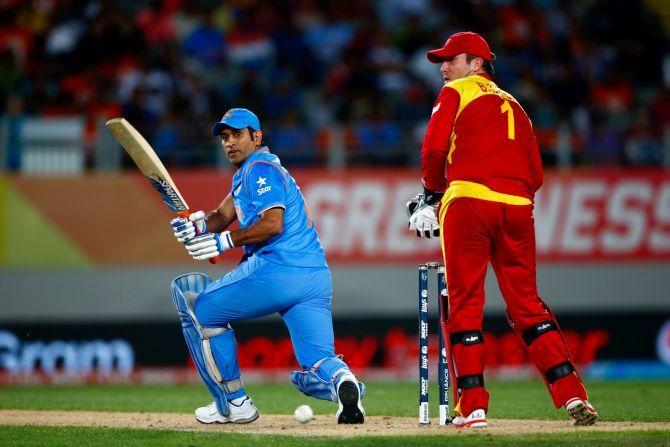
Raina settled into the chase with an assault on Sean Williams in the 30th over, first dancing down to thump him over midwicket and when the bowler tried the flatter trajectory, lifting with effortless power over the long on boundary.
At the other end, Dhoni bided his time, worked the ball around into vacant spaces with shots all his own -- the kind of strokeplay that drives up the blood pressure of fans and purists alike.
There was an inevitability about their chase. At the 25 over mark, India were behind the pace, having managed 98/4 to Zimbabwe's 101/3. By the 30th over, the chase was on level terms (India 127/4 to the opposition's 128/4). The Zimbabwean innings had imploded after the 41-over mark -- the key to this chase was all about whether the captain and his accomplice could bat the game out.
They did, with a composure that nothing seemed to shake. The power play was taken in the 36th over (at which point India was 158/4, as was Zimbabwe). Disciplined bowling kept the Indians down to just 39 runs but at no time did either seem to fret at the relative lack of opportunities to blast their way to freedom.
When they could, they hit with venomous power; when such freedom was denied, they pushed and nudged and nurdled and hared between wickets, content to keep ticking them over.
At 197/4 after 40, the game had turned totally around -- 91 off the last 60 is commonplace these days for set batsmen with the luxury of wickets in hand. Raina took on the onus of ensuring that the chase never got out of hand, first turning the screws on Hamilton Masakadza in the 42nd over with a powerful drive through covers followed by a mow into the stands over cow corner; Chatara was glided, Mupariwa nudged, the boundaries kept coming and in the 45th, so did the century -- Raina's first in World Cups, 94 balls, 8 fours, four sixes) -- that had seemed inevitable once the left-hander had settled down under the steadying influence of his captain.
Given the velocity of Raina's scoring, Dhoni -- who reads a chase better than most -- settled very early into a supporting role, opening out just often enough to ensure that his partner never felt the pressure.
Both batsmen had their share of luck, Raina being dropped by Hamilton off an attempted sweep that the fielder made a total meal of in the 35th over, with the batsman on 48 at the time, while several of Dhoni's bottom-handed heaves fell desperately short of diving fielders.
But those alarums apart, the result seemed inevitable almost throughout their unbeaten 196-run partnership; almost as if to rub it in, Dhoni (85 not out off 76 with eight fours and two sixes) finished the game off with a thumping heave over backward square leg in the 49th over to seal the win with six wickets, and eight deliveries, in hand.
Raina (110 off 104 with nine fours and four towering sixes) met his captain mid-pitch for a matter of fact hug; the two walked off as casually as if they'd just had a little hit-about.
It was the highest successful chase by India in a World Cup; it was M S Dhoni's 10th successive win at this level shading the 9-win sequence recorded by West Indies skipper Clive Lloyd.
But more to the point, it was the most searching examination of the team's resilience with bat and ball that India had yet faced in his tournament. They felt the pressure in both departments, but each time the pressure intensified, India found -- as teams will when they are on a collective roll -- someone to put his hand up and reel the game back within reach.
DON'T MISS PREM'S EARLIER MATCH REPORTS!


